|
|
This morning, 9 June 2009, Phil Schiller, with help from Bertrand Serlet and Scott Forestall, outlined the directions Apple is taking in the next year or so and introduced new notebook computers and a new iPhone, the iPhone 3G S.
We decided to takea short cut through some gardens where some older folks were fan dancing (the Chinese kind not the type that was done in the 1930s) only to find that the doors to a building we were cutting through, were closed, so we had a longer detour in the end. At breakfast and here, we chatted about what was expected and I was certain that Steve Jobs would not appear. I am convinced that it would have been the wrong move for Apple had he done so. The best executives know that a departure should be early rather than late (a look at current UK politics might illustrate this).
Of course, as we arrived, the girls went and we were led into the Moscone Center for media registration. The line was short and this was nothing like the MacWorld melée. This is run by Apple. When I handed my name card to the nice lady on one of the computers, she said, "Oh, I recognise that name", which was nice to hear. The media card was in my hands in seconds and I turned round in time to see Scott Forstall walk towards the lift. Like some keynote speeches at MacWorld, Phil Schiller's appearance at the Apple world Wide Developer conference at the Moscone Center, San Francisco, was being watched keenly for directions the corporation is taking. While the next iPhone software update and news on the update to OS X were expected, we were less sure about other announcements, but from the start, this was both a presentation for developers and for users. Upstairs we were in a mix of media and VIP badges. And, arriving around 9am, we were early of course. Many of those attending were by the gates that rise when we are allowed in, and it was not until 9:30 that I made my move in that direction. Timing was good and they were open almost immediately with the video guys in first -- they set up on the left side -- then the rest of us racing for the seats. Like MacWorld, I headed for the left and ended up in a seat about 4 rows from the front. Not such a good angle for photographs, but you can't have everything.
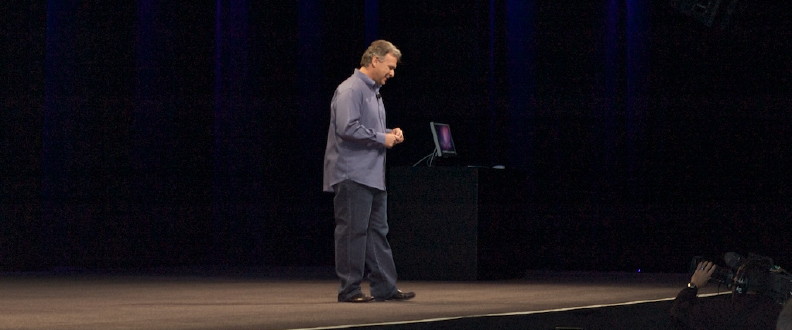
He moved swiftly to the range of notebook computers, all of which were updated, starting with the 15" MacBook Pro which is now to have an improved performance, improved battery life using technology that was introduced with the 17" Mac Book Pro last year, and a new price: starting some $300 less than before at $1699 (58,000 baht). The unibody construction has made the MacBook Pro and the MacBook thinner and lighter than before. The 15" MacBook Pro now comes with several processor options starting at 2.53Ghz and going up to 3.06Ghz and comes with 4GB RAM as standard. It can now handle 8GB of RAM. The display has been improved. The lithium-polymer battery has far better efficiency and life. It can last for up to 7 hours of use and can now accept some 1,000 charges, up from 300, before there is deterioration. This gives up to 5 years of battery life Apple claims. There are several hard disks available with the 250G standard for the 2.53Ghz computer and up to 500GB for the 2.8GHz model ($2299 - 79,000 baht). There is also an option of a 250GB solid state hard drive (SSD). An interesting addition to the specifications is an SD card slot to replace the Express 34 slot which had been underused. The 17" MacBook Pro also saw an upgrade to a 2.8Ghz processor, plus a 500GB disk and 4G RAM as standard for its base price of $2499 (86,000 baht). These updated MacBook Pro computers are shipping immediately. The MacBook is a 13" notebook computer aimed at the home user or student and these have also been improved, while they are now renamed MacBook Pro to emphasise the improvements and increased capabilities. Like the 15" MacBook Pro the display of this device is also improved and the computer now has the backlit keyboard and the SD card slot. Also added is a Firewire 800 port. Like its larger cousins, it can handle up to 8GB RAM and starts at $1199 (41,000 baht) for the 2.26Ghz version with 160GB hard disk and $1499 (52,000 baht) for the 2.53 GHZ with 250GB disk. I made a note: "My next machine?" These computers are also available as from the day of the conference. Phil Schiller mentioned that the white polycarbonate MacBook had been updated recently, so to complete the lineup, the MacBook Air was also being improved with 1.86 and 2.13GHz processors: the latter now priced at $1799 (62,000 baht). He also emphasised the environmental credentials of all these Macs with certificates of compliance from EPEAT and Energy Star, before introducing Bertrand Serlet who was to run through the new version of OS X: 10.6, Snow Leopard.
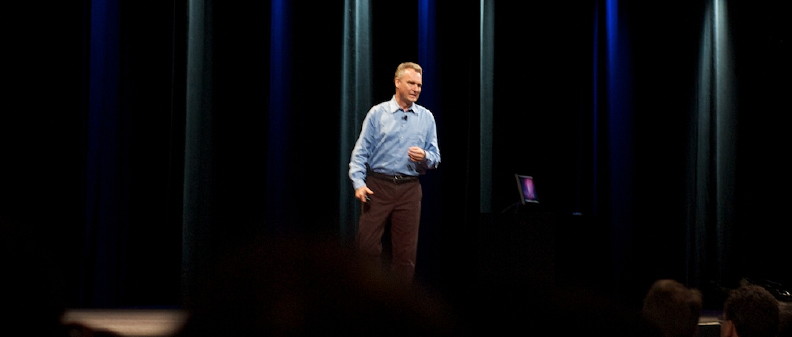
He began with the interface which while not changed on the surface now opeates more efficiently to improve speed and operations. The Dock has been rewritten to improve its handling of clutter and works with Stacks in a new way. Installation of the new OS, when it comes in September, is faster and saves up to 45% of space with disk space recovered. Serlet was pleased to announce changes to the way that Preview handles images and PDF files, particularly the improved text selection method. He also discussed the way that Chinese input has been changed and now works with the trackpad. Several of the applications that are used day to day are faster, especially Mail and Safari, with version 4 of the latter being released immediately for both Macs (Leopard and Tiger) and Windows. Those who run Safari with plugins will be happy about a new feature that means only the page with difficulties will close (for example with Hi5) and not, as before, see a crash of the browser. Safari is 100% Acid 3 compliant. Snow Leopard handles 64-bit operations better so can deal with multi-processor environments more efficiently and the OS also has a new version of QuickTime (QT 10) that is color correct, handles downloads via HTTP streaming and works with any webserver. The user interface has changed and the controls are absent from the page when a video is running in a similar way to the way a fullscreen display is shown on the iPod touch. Bertrand Serlet gave way to Craig Federighi, Apple's VP for Mac OS Engineering who spent several minutes demonstrating the improvements that Serlet had outlined. He was particularly keen to show stacks as used in the Dock as a way to examine open windows in specific applications instead of all and the integration between applications when using this. In QuickTime he also showed a new editing feature that allows the video to be displayed also as clips and the way that these could be selected and edited, as well as being used in other applications.
Bertrand Serlet and announced the release was to be September and the upgrade for current Leopard users, previously $129 was $29 (1,000 baht) with a Family Pack at $49. A developer's preview version was available to those at the conference.
After a video of several success stories, he thanked the developers themselves and examined the new version of the iPhone OS which, he said, has over a hundred new features, including cut, copy and paste, landscape support for keyboards in all apps, and multimedia messaging which will be handled in the same app as SMS. This will be available with 25 carriers immediately with others added later. The search facility has been extended and now works across applications. Spotlight searches can also be done as in OS X, and it is possible to launch a an app from the search result. Among other improvements were parental controls, an improved Safari with autofill and HTML 5 support; and tethering, by which a Mac or PC can connect to the internet via the iPhone. For local users, Scott specifically mentioned the new support for Thai among several new languages newly available with the iPhone OS and displayed a slide showing the Thai keyboard which works in portrait and landscape mode. A new feature, Find my iPhone, is to be available for Mobile Me users, that will track down a misplaced or stolen phone and send a signal to make a sound (even when in silent mode) or to send a remote, "wipe" command to delete all data. If found later, it can be restored using the backup feature. Other important features included support for peer to peer connectivity in apps so that, for example, interactive games may be played; the ability to create companion software for hardware accessories, such as a blood/glucose monitor developed by Johnson and Johnson; Maps which can be embedded into a developer's app and include directions; and Push notifications for 3rd party software that allow text, numerical badges and custom sound alerts to be sent to a user. There were several demos of apps produced by third party developers who had used the 3.0 SDK before Scott returned to the stage and announced that the 3.0 update would be available worldwide on 17 June: free to iPhone users and with a fee of $9.95 for users of the iPod touch. Developers were:
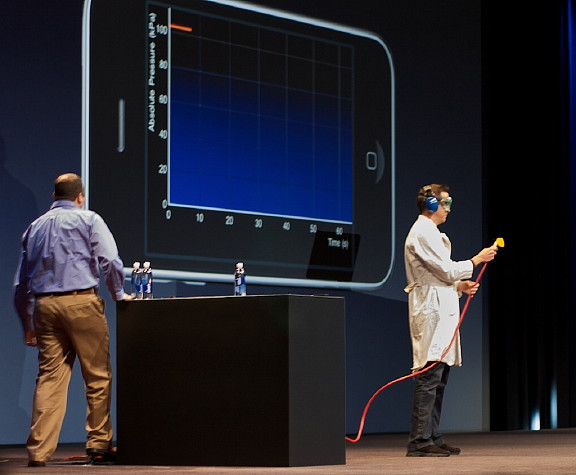
This is a faster version of the current iPhone with some additional hardware changes making it about twice as fast as the current iPhone. Of particular note are the new 3 mega-pixel camera with autofocus, auto-exposure and auto-white balance; plus a new "tap to focus" feature that was well-received. The camera now makes it possible to record video as well and there were similar clip editing features that had been seen with Quick Time 10 allowing video to be sent by Mail, MMS, or to Mobile Me or You Tube directly from the iPhone. There is also a feature called Voice Control for apps and iPhone use as well as other accessibility settings that are similar to Universal Access that can be used on OS X to assist those with disabilities. As expected, but nonetheless well-received, was the compass which has its own app, but also integrates with Google Maps, including display orientation. This new iPhone is also to have support for the Nike + system. Hardware encryption is built in to the device and integrates with Mobile Me. Among other things this allows instant deleting of personal data. The iPhone 3Gs also has better battery life and like other products announced is more environmentally friendly with use of materials like arsenic-free glass. The price of the new iPhone, which is really a product increment, is to be $199 in the US for the 16G version, with a new 32G phone at $299. Schiller emphasised these were prices for phone bought for use with AT & T in the US with pricing varying around the world. the new phones will be on sale on 19 June in America and at other times around the world, including Thailand on 9 August. Phil Schiller gave a confident and professional presentation throughout, displaying confidence throughout as well as knowledge of the products. With the MacBook Pro, Snow Leopard, iPhone OS 3.0 and the new iPhone 3Gs, Apple has a strong line-up for consumers; and the developers were handed a clear road map of where they and Apple are going. 
|
|

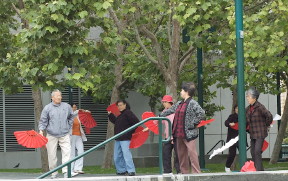 Malini, the Apple media person who looks after us, was once again dressed in a sleeveless outfit. I don't know how she does it as I am wrapped up in a leather jacket and Grace from Singapore also has a warm top as do others. Mind you, Malini was over-dressed compared to what we saw outside Moscone.
Malini, the Apple media person who looks after us, was once again dressed in a sleeveless outfit. I don't know how she does it as I am wrapped up in a leather jacket and Grace from Singapore also has a warm top as do others. Mind you, Malini was over-dressed compared to what we saw outside Moscone. Across the road from the Moscone Center, the cameraman from the Philippines almost had a coronary and rushed to set up his camera as, in a sort of cross between demonstration and publicity, there were a couple of girls in bikinis from iPorn. This was part of a protest at Apple who sem to be trying to keep the App Stores clean.
Across the road from the Moscone Center, the cameraman from the Philippines almost had a coronary and rushed to set up his camera as, in a sort of cross between demonstration and publicity, there were a couple of girls in bikinis from iPorn. This was part of a protest at Apple who sem to be trying to keep the App Stores clean. 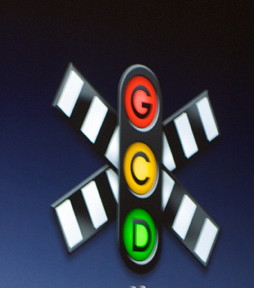 When Serlet returned to the stage, he summed up the new features of Snow Leopard including faster graphics and multi-core processing using a feature of OSX that Apple calls Grand Central Station which returns resources to the system in the way that threads are handled. He was also keen to examine the way that Apple has integrated support for Microsoft Exchange in Mail, Address Book and iCal. These features were again demonstrated by Craig Federighi. This was well received especially when a feature which shows attachments to mail even when the original Microsoft program (for example Power Point) is not installed. Also of note was the way it was possible to click and drag names from the Address Book into iCal to schedule meetings.
When Serlet returned to the stage, he summed up the new features of Snow Leopard including faster graphics and multi-core processing using a feature of OSX that Apple calls Grand Central Station which returns resources to the system in the way that threads are handled. He was also keen to examine the way that Apple has integrated support for Microsoft Exchange in Mail, Address Book and iCal. These features were again demonstrated by Craig Federighi. This was well received especially when a feature which shows attachments to mail even when the original Microsoft program (for example Power Point) is not installed. Also of note was the way it was possible to click and drag names from the Address Book into iCal to schedule meetings.